Explore the importance of talent development, plus how to create a high-impact talent system that drives your organization forward.
How do you prepare your organization for a future where skills can become obsolete at an unprecedented pace? The answer lies in transforming your company into an engine of human capability. Talent development is the most powerful lever for future-proofing the workforce, moving beyond simple training to a systematic process of upskilling and reskilling your people to ensure they – and the whole business – remain agile and competitive.
|
Author: Jonathan M. Pham |
Highlights
- Talent development (TD) is a strategic and continuous process focused on enhancing employees’ skills, knowledge, and abilities to meet an organization’s current and future business objectives. A crucial imperative for modern businesses, it helps address the widening skills gap caused by AI, improves employee retention by offering growth opportunities, and directly boosts organizational performance and profitability.
- These days, talent development programs have evolved beyond traditional training to include a diverse toolkit of formal workshops, personalized coaching and mentoring, on-the-job training, microlearning, and strategic applications like upskilling, reskilling, experiential learning, and social learning.
- Building a high-impact talent system involves a three-phase blueprint: aligning and assessing by strategically linking development to business goals and identifying skill gaps; designing and delivering personalized learning journeys through blended ecosystems; and measuring and refining impact using a balanced scorecard of metrics and continuous feedback to ensure ongoing improvement and ROI.
- Securing leadership buy-in and budget, addressing low engagement, and combating the “forgetting curve” are key challenges in talent development; these can be overcome by demonstrating ROI, ensuring relevance with managerial support, and designing programs for continuous application rather than just information delivery.
- The future of talent development is expected to be shifting towards AI-powered personalization, focusing on human-centric competencies that machines can’t replicate, and democratizing learning by empowering individuals to take ownership of their own growth.
What is Talent Development?
Talent development (TD) is the strategic and continuous process of developing the skills, knowledge, and abilities of an organization’s employees to meet both current and future business objectives. It is an integrated approach that encompasses attracting, developing, engaging, and retaining the individuals needed for long-term success.
As part of the employee lifecycle, talent development is a critical pillar that sits within the broader framework of Talent Management.
| Term | Primary Function |
Core Question Addressed
|
| Talent Development | Growing them while they are here |
“How do we build the skills our people and business will need in the future?”
|
| Talent Acquisition | Getting them in the door |
“How do we find and hire the best people for our needs today?”
|
| Talent Management | The overarching strategy |
“How do we create an integrated system to manage the entire employee lifecycle, from hire to retire, to achieve our business goals?”
|
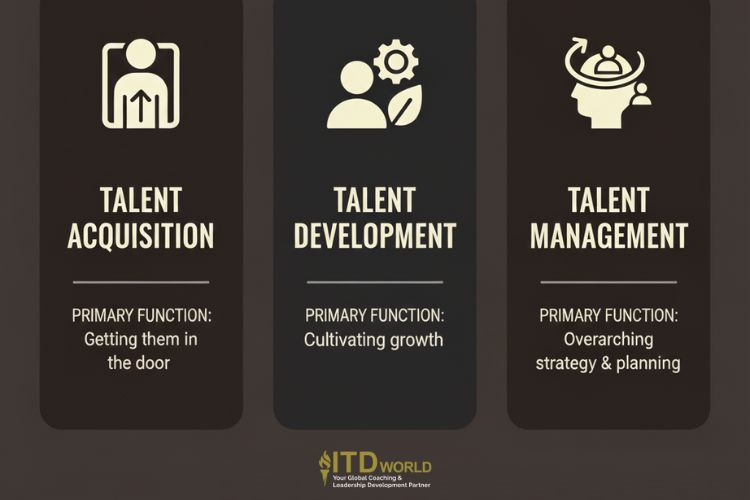
Talent development vs talent management & acquisition
Is Talent Development the Same as HR and L&D?
Within the Human Resources (HR) function, the terms Talent Development (TD) and Learning and Development (L&D) are sometimes used interchangeably; however, in modern practice, there is a crucial strategic distinction. Generally speaking, TD takes a more forward-looking, holistic view.
| Aspect | Traditional L&D (Learning & Development) |
Modern TD (Talent Development)
|
| Primary Focus | Training delivery and cultivating skills for an employee’s current job. |
Cultivating capabilities and career paths for one’s future roles.
|
| Duration | Often short-term and reactive (e.g., training on a new software). |
Long-term and proactive (e.g., establishing a 5-year leadership pipeline).
|
| Scope | A series of training events or courses. |
An integrated system including coaching, mentoring, succession planning, and strategic career pathing.
|
As you may see, while traditional L&D is a vital part of the puzzle, Talent Development is the future-focused engine that prepares the organization and its people for what’s next.
The Importance of Talent Development
The modern business landscape is being reshaped by powerful forces that make a systematic approach to people development a non-negotiable for survival and success.
- The widening skills gap in the age of AI
The rapid advancement of artificial intelligence and automation is making many existing skills obsolete at a record-breaking speed. The World Economic Forum predicted that 59% of all employees would need reskilling by 2030 – a pressing reality for businesses globally. Organizations that are not actively investing in future-proofing their workforce are facing a significant and growing capability gap.
- The decisive role in the war for retention
In today’s competitive labor market, the single biggest differentiator is often the opportunity for growth. Top talent will not stay in a role where they feel they are stagnating. On the other hand, 94% of employees say they would stay longer at a company that invests in their career development. This makes talent development one of the most powerful and cost-effective retention tools an organization possesses.
- The direct link to performance & profitability
Research by Deloitte reveals that companies with a strong learning culture experience up to 1.5 times the retention rates of their peers. This stability, combined with a more skilled workforce, directly translates to higher productivity and financial performance.
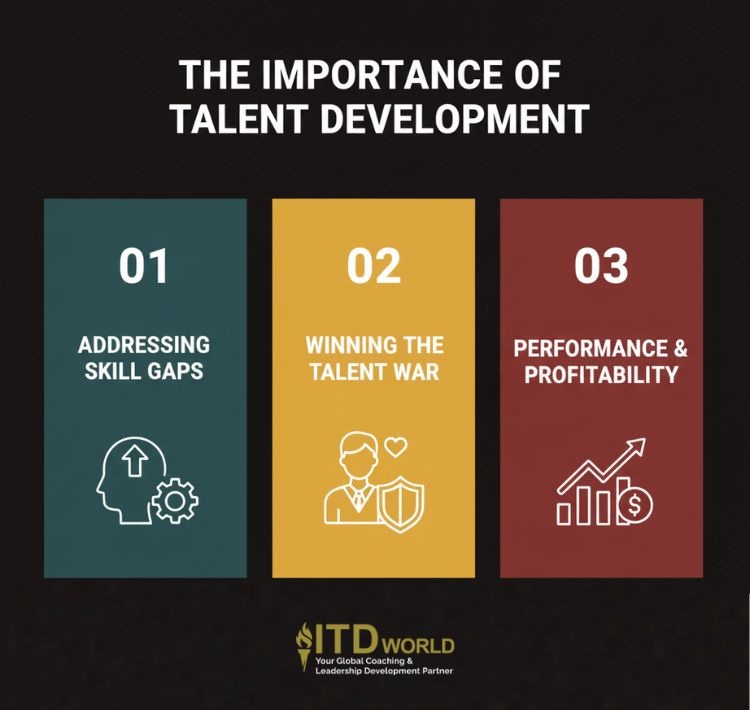
Talent Development Case Studies in Action
Many of the world’s leading companies are well aware of this business case – and therefore have made talent development a cornerstone of their strategy, yielding impressive and quantifiable results in the process.
- AT&T – The ROI of Reskilling: Facing massive technological disruption in the telecommunications industry, AT&T launched a monumental upskilling and retraining program for its workforce. The result was not just a more future-ready team, but a reported 131% return on investment, as the company found it was significantly more cost-effective to retrain its current people than to hire new ones.
- Marriott – The Power of Internal Mobility: The global hospitality leader has a long-standing commitment to growing its talent from within. This is demonstrated by remarkable statistics, such as its ability to fill approximately 55% of its leadership roles internally in key regions like Australia.
- Randstad – Reducing Turnover Through Mentorship: The global HR services firm implemented a formal mentoring program to develop and support its talent. Later, it was noted that participants were 49% less likely to leave the company, showcasing how a single, well-executed talent initiative can have a massive and immediate impact on retention.
Types of Talent Development Programs
To meet the complex challenges of the modern workplace, the field of talent development has evolved far beyond traditional, one-size-fits-all classroom training. Today, world-class organizations deploy a diverse “toolkit” of programs to create a flexible, engaging, and continuous learning environment.
- Formal training workshops: These structured sessions, delivered either virtually or in-person, are excellent for imparting foundational knowledge, teaching specific skills, and ensuring a consistent message is delivered to a group.
- One-on-one coaching & mentoring: A highly personalized approach for accelerating the growth of high-potential individuals and senior leaders. Coaching focuses on unlocking a person’s own potential, while mentoring involves guidance from a more experienced colleague.
- On-the-job training & apprenticeships: A practical, hands-on method where learning is directly integrated into one’s daily workflow, guided by an expert or manager.
- Microlearning & e-learning: Delivering bite-sized, on-demand digital content – such as short videos, articles, or interactive modules – that one may access at their own pace and moment of need.
Having the right programs is not enough; they must also be applied through a strategic framework to address specific business needs.
- Upskilling & reskilling: A critical strategy for closing capability gaps. Upskilling focuses on deepening one’s competencies in their current role to enhance performance and keep them relevant. On the other hand, reskilling involves training one for a completely new role within the company – often in response to technological shifts or changing business priorities.
Example: An organization might upskill its marketing team on the latest AI-powered analytics tools, while reskilling employees from a declining administrative department for in-demand roles in customer success.
- Experiential learning: Based on the principle that people learn best by doing, it involves intentionally assigning challenging projects that are just beyond one’s current capabilities to accelerate their growth.
Example: A promising manager is tasked with leading a cross-functional “stretch” assignment or taking on a temporary assignment in a different country to build their global business acumen.
- Social learning: Fostering an environment where individuals may learn from each other. It is one of the most effective and scalable development strategies.
Example: Creating formal peer mentoring programs, establishing “communities of practice” for specific skill areas (e.g., a data science guild), and encouraging informal knowledge-sharing through internal platforms.
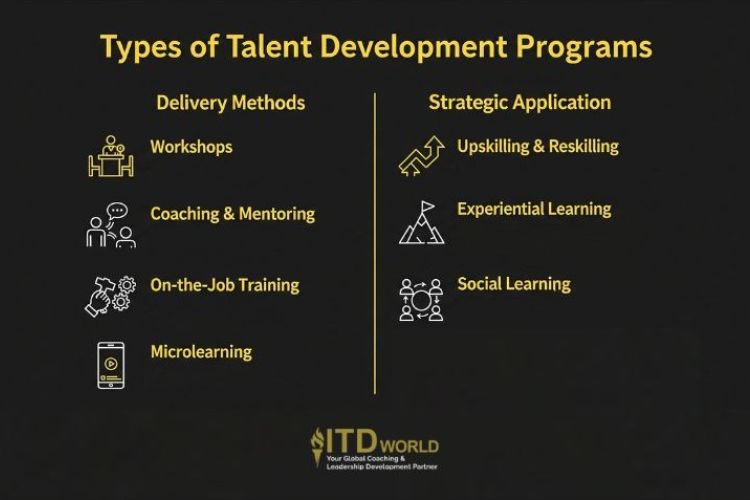
Steps in Developing Talent: How to Build a High-Impact System
The following three-phase blueprint provides a practical framework that HR and business leaders may leverage to move from random acts of training to a high-impact system that drives measurable results.
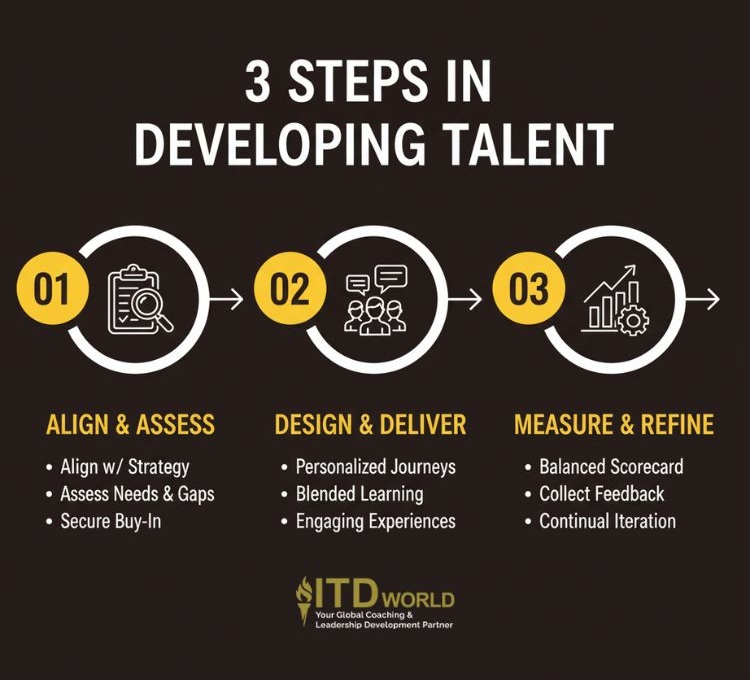
-
Align & assess: The strategic foundation
The initial planning phase is the most critical, as it ensures that your entire system is built to solve the right problems and support the company’s future. Getting this step right is the key to demonstrating a clear return on investment.
- Align with business strategy: The first question must always be: “What are our organization’s key strategic goals for the next 1-3 years?” For instance, if the company is focused on digital transformation, the development priority should be digital skills.
- Assess needs & identify gaps: This involves a thorough Training Needs Analysis (TNA) – where the HR team or those in charge survey leaders about the competencies their teams will need to execute a new strategy, analyze performance data to spot recurring challenges, and review succession plans to pinpoint gaps in the leadership pipeline.
- Secure buy-in: Use the data gathered to get senior executives to see talent development not as a cost center, but as a critical investment in the company’s future success.
-
Design & deliver: The execution stage
The second stage is where your strategic plan is translated into engaging learning experiences for your employees.
- Create personalized journeys: Recognize that people come with different needs; hence, distinct development paths should be designed for different segments of the workforce.
Example: A learning journey for a new manager might focus on foundational skills like giving feedback and delegation, delivered through workshops and a mentoring program. On the other hand, a high-potential director might require a cross-functional “stretch” assignment, one-on-one executive coaching, and a course on financial acumen.
- Leverage a blended learning ecosystem: Choose the right mix of programs, and deliver them through a user-friendly Learning Management System (LMS) or Learning Experience Platform (LXP) to make learning experiences accessible and engaging.
-
Measure & refine: Ensuring ROI & continuous improvement
The final phase is about closing the loop, proving the value of the system, and driving its ongoing evolution.
- Use a Balanced Scorecard of metrics: To measure impact effectively, track both leading indicators (e.g. participation & completion rates, employee satisfaction scores on the training, etc.) and lagging indicators (i.e. the key business metrics defined in Phase 1, such as improvements in retention, higher internal promotion rates, and better team performance on their KPIs).
- Solicit feedback & iterate: A talent development system is never truly “finished.” You must use the data and input gathered in this step to continuously refine and enhance your programs, ensuring they remain relevant and impactful as the business needs evolve.
15 talent development strategies – by Prof. William Rothwell
Talent Development Plan Template
This Talent Development Plan is a strategic tool for managers and employees to collaboratively create a roadmap for professional growth. It is designed to align an individual’s development with the organization’s core business objectives, ensuring that learning is both purposeful and impactful.
Section 1: Individual & Role Information
Employee Name: _________________________
Current Role: _________________________
Manager Name: _________________________
Date: _________________________
Section 2: Strategic Alignment
1. Key Business/Team Goal this Development will Support:
(e.g., “Improve customer retention by 10% in the next fiscal year.”)
2. How this Employee’s Growth Contributes to that Goal:
(e.g., “By becoming an expert in our new customer success platform and developing advanced client management skills.”)
Section 3: Assessment of Skills & Potential
1. Current Strengths to Leverage:
(What skills and talents does the employee currently excel at?)
2. Key Skill/Competency Gaps to Address for Current & Future Roles:
(Based on performance reviews, 360-feedback, and career aspirations.)
Section 4: Development Goals
Define 1-3 SMART (Specific, Measurable, Achievable, Relevant, Time-bound) goals for this development period.
Goal 1:
Goal 2:
Section 5: Action & Learning Plan
For each goal, detail the specific actions that will be taken.
| Development Goal | Action Steps / Learning Methods (e.g., Formal Training, Coaching, Stretch Assignment, Self-Study) | Resources Needed (e.g., Budget, Manager’s time) |
Timeline / Deadline
|
| Example: Develop advanced client management skills. | 1. Complete the ‘Advanced Client Negotiations’ workshop.2. Be mentored by Jane Doe on the ACME account.3. Lead the next quarterly business review for a key client. | Workshop budget approval; 1 hr/month with mentor. | End of Q4 |
| Goal 1: | |||
| Goal 2: |
Section 6: Measurement & Follow-up
1. How will we measure the success of this plan?
(e.g., “Successful completion of the workshop,” “Positive feedback from mentor,” “Improved customer satisfaction scores on their accounts.”)
2. Manager’s Commitment (What I will do to support this plan):
3. Review Schedule (Check-in Dates):
We will formally review progress on this plan on [Date 1], [Date 2], and [Date 3].

Challenges of Talent Development
- Securing leadership buy-in & budget
As crucial as it is to organizational success, talent development is often perceived as a “cost center” rather than a strategic investment, making it difficult to secure the necessary budget and sustained commitment from senior leadership, especially during periods of economic pressure.
Solution: Consistently speak the language of business and demonstrate ROI. Specifically, those in charge must act as a business partner – by presenting a clear, data-driven case that links every development initiative directly to a strategic business priority.
Example: Instead of presenting a budget based on the number of courses, frame it around business outcomes. For instance: “We are requesting a budget of X to launch a development program for our high-potential sales managers. Based on our pilot data, we project this will reduce turnover in this critical group by 15%, saving the company Y in recruitment costs, and contribute to a 5% increase in their teams’ sales performance.”
- Low engagement
One of the most frustrating scenarios is investing in a new learning platform or program, only to see low participation rates. Employees may be too busy with their daily tasks, fail to see the relevance of the training to their career, or lack the motivation to proceed.
Solution: Ensure relevance & secure managerial support. First, the learning content must be highly personalized to the individual’s needs and career path. Second, and more importantly, the direct manager must be an active champion of their people’s growth.
Example: When a manager begins their one-on-one meetings by asking, “What did you learn from the module you completed this week, and how can we apply it to our current project?”, it sends a powerful signal that development is a real priority, not just a passive HR initiative.
- The “Forgetting curve”
This is the well-known phenomenon where people attend an excellent workshop but forget the majority of what they learned within a few weeks – because there is no mechanism to reinforce the new skills back on the job.
Solution: Design for application, not just for information delivery. Learning must be a process, not a one-time event. To overcome the problem, one must ensure reinforcement and application directly into the program design.
Example: An effective development journey doesn’t end when the workshop is over. It should include follow-up mechanisms to ensure the learning is transferred. After a formal training on “giving effective feedback,” participants could be placed into peer coaching groups to practice what they have learned, or be given a “stretch” assignment that requires them to apply it with their teams. A focus on application is what turns knowledge into a real, lasting capability.

The Future of Talent Development: Key Trends
- AI-powered personalization at scale
The era of the “one-size-fits-all” training catalog is ending. The future of talent development is about delivering a unique, personalized learning journey for every single employee, and Artificial Intelligence is the key enabler of this shift.
In practice: Imagine a Learning Experience Platform (LXP) that functions like a “Netflix for learning.” Powered by AI, it analyzes one’s current role, identified skill gaps, and stated career aspirations. It then recommends a “playlist” of relevant content – from internal microlearning videos and mentorship opportunities to external online courses – hence creating a development path that is uniquely engaging for that individual.
- An intense focus on “human-centric” competencies
Paradoxically, as AI and automation handle more routine and technical tasks, the most in-demand skills are becoming more deeply human. The competitive advantage of the future will lie in the capabilities that machines cannot easily replicate – including strategic & critical thinking, creative problem-solving, collaborative influence, and empathetic leadership. These are the capabilities that will enable the workforce to partner with new technologies and navigate complex, unforeseen challenges.
- The democratization of learning
The traditional, top-down, HR-driven model of development is giving way to a more flexible approach where employees are empowered and expected to take greater ownership of their own growth. In other words, the organization’s role is evolving from being the sole “provider” of training to being a “facilitator” of learning.
In practice: This is being achieved through on-demand learning platforms, company-funded personal learning budgets, and the encouragement of employee-led “communities of practice” where peers can share knowledge and best practices. This approach fosters a more agile and proactive learning culture that aligns with the modern employee’s desire for autonomy and self-direction.
Read more: 10 L&D Trends to Help Your Workforce Thrive
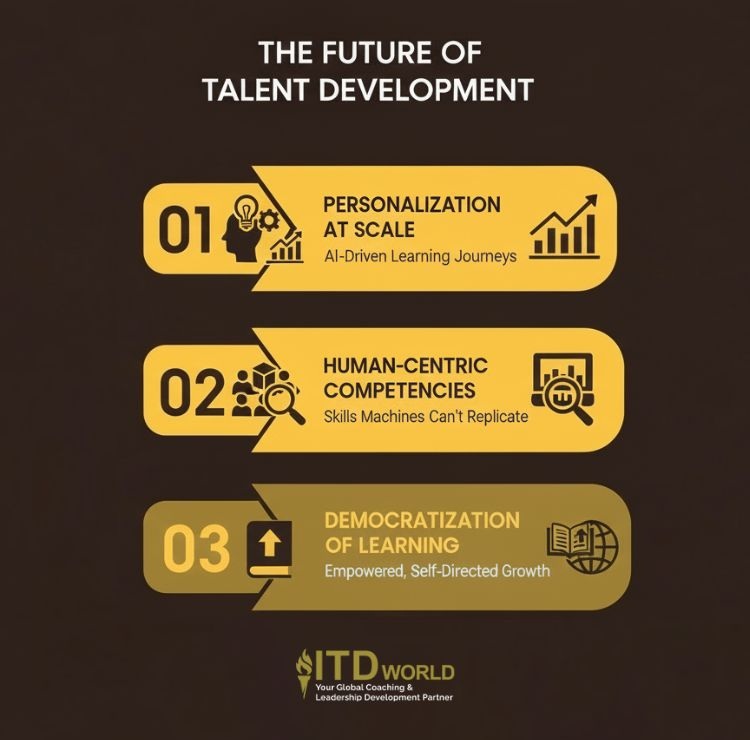
Tips for aspiring talent development specialists
Talent Development Quotes
Check out more talent quotes here!
Train people well enough so they can leave, treat them well enough so they don’t want to.
Richard Branson
Talent wins games, but teamwork and intelligence win championships.
Michael Jordan
Talent is cheaper than table salt. What separates the talented individual from the successful one is a lot of hard work.
Stephen King
You don’t build a business—you build people, and then people build the business.
Zig Ziglar
Leadership is unlocking people’s potential to become better.
Bill Bradley
Talent Development Books
- Growing Great Employees by Erika Andersen: Uses a gardening metaphor to explain how leaders can cultivate thriving, productive teams through coaching and intentional development.
- Conscious Business by Fred Kofman: Explores how aligning work with core human values contributes to more dynamic, ethical, and successful organizations.
- Design for How People Learn by Julie Dirksen: A practical guide to creating engaging learning experiences based on how people actually absorb and retain information.
- Workplace Learning by Nigel Paine: Argues for promoting a culture of continuous learning through open communication and knowledge sharing.
- Everyone Deserves a Great Manager by Scott Jeffrey Miller et al.: Outlines six essential practices for managers to better lead teams and unlock employee potential.
- Driving Performance Through Learning by Andy Lancaster: Demonstrates how learning and development can directly improve productivity, performance, and profits.
- Impact Players by Liz Wiseman: Reveals the traits and behaviors that make certain employees indispensable – plus how to cultivate them.
- Map It by Cathy Moore: A hands-on guide to designing strategic training that solves real business problems and delivers tangible results.

Discover ITD World’s Talent Development Programs
At ITD World, we have years of experience in providing the strategic frameworks and world-class certifications needed to establish a future-ready workforce. Our training solutions are designed to support every phase of the talent development blueprint, helping turn your people into the greatest strategic asset.
- World-class certifications: ITD World’s certification programs, designed by global thought leaders like Dr. William Rothwell and others, offer the complete toolkit for talent strategists. Examples inlcude:
- Certificate In Talent, Competency And Succession Management (CTCSM): To master the art of identifying and managing a robust talent pipeline.
- Certified Talent Development & Learning Professional (CTLP): To design and execute high-impact learning journeys that drive business results.
- Programs for developing your leaders: We also offer a full range of solutions to cultivate the talent you have identified, including our Senior Leadership Development Program (SLDP) for preparing high-potentials for executive roles, and our coaching programs (e.g. the Certified Coaching & Mentoring Professional – CCMP) for promoting an internal coaching culture that fosters continuous growth.
Ready to turn your talent into a powerful strategic advantage? Contact ITD World today to learn how our solutions can help!
Other resources you might be interested in:
- Talent Philosophy: Unlocking Workforce Potential
- Talent Transformation: Build a Future-ready Pipeline
- Employee Development Plan: Fueling Future Success

